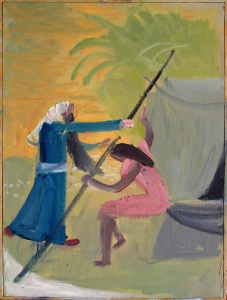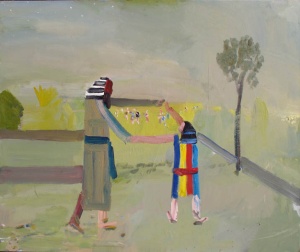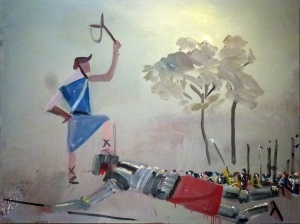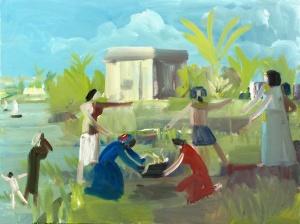Bradford’s Borders Revisited
John Bradford’s paintings span over 40 years of intensive exploration of the joys of the biblical narrative. He has explicated its myriad passionate moments from almost every narrative in Genesis, Exodus, Bamidbar to the stories of Tanach such as Ruth and Naomi, David and Bathsheba and Mordechai and Esther. Over the years his style has shifted to probe the literal narrative versus the painterly gesture and deeply abstracted expression. Finally here in this current exhibition, he concentrates on the kinds of distinctions and divisions that are so central to a Biblical understanding.
Garden of Eden is an After the Fall vignette that challenges the normative narrative. Here Eve stands before a thrusting snake seeming to implore for more ripe red fruit. Adam is already hard at work in the fields and yet his faithless wife continues to seek the forbidden fruits of Eden. As the artist comments: “Knowledge is linked to sin.” Eve appears deeply hesitant to leave the Garden, unwilling to go beyond its borders.

In a shockingly similar motif, we find Judah struggling with a prominent rod held by his daughter-in-law, the desperate but hapless Tamar. Pictorially it is a classic master/slave motif and yet we realize that for all of the complexity as the drama unfolds, it is Tamar who will remain in control to fulfill her destiny to engender the Davidic line. The powerful diagonal division between male and female becomes Tamar’s measure of power as she seems to draw Judah into the waiting tent.

Bradford subtly shifts gears in Jacob Sends Joseph to the Fields of Shechem. At first the scene seems to be simply a lovingly parental farewell. With Joseph and his multicolored coat visible as a dramatic anchor, father and son are an inextricable team. And yet their arms embrace and indeed capture the very brothers seen in the distance who have sworn to kill Joseph. And so we notice that many aspects of the spare landscape are bound and bordered with a kind of determination reflecting a Divine plan. Indeed, it is only in the brother’s hatred of Joseph, his sale and descent to Egypt that the Divine plan will unfold resulting in the final creation of the Jewish people blessed with the Torah. One could say that this moment, along with Joseph’s dreams (notice the white stars in the upper left) is the real genesis of the Jewish nation.
The importance of borders is of course central to the Jewish view of the world. Genesis is obsessed with distinctions; light and dark, upper waters and lower waters, earth and heaven; on and on it goes to male and female, God and Man. Only God is One, while the universe is fundamentally about distinctions, from the distinctions of peoples to the borders of nations. When they are respected, there can be peace, when they are violated, chaos ensues. This vital notion has guided Bradford’s approach to the Biblical narratives he paints.

David and Goliath presents us with another kind of border; the division between Arrogance and Truth. As Goliath taunts the Israelites, “for he has disgraced the battalions of the Living God!” David responds that “you come to me with a sword, a spear, and javelin, but I come to you with the Name of Hashem, Master of Legions, the God of the battalions of Israel that you have ridiculed” (I Samuel 17:45). In Bradford’s painting David stands astride the fallen Goliath, his humble slingshot raised in triumph. But it is not the slingshot that won, rather, in a well considered metaphor; it is the barely concealed sun behind the trees that reflects that it is the Ruler of the Universe who controls all such disputes. The tension between these naturalistic elements and the overall graphic austerity of the image opens up this radical interpretation.

Finally the border between life and death. Moses is the child in peril, a decree against his life. And yet through subversion and perhaps miracle, this infant survives, saved by Pharaoh’s daughter, named no less, Batyah, daughter of God. Bradford’s painting is classical, evoking the balance of Poussin as he introduces a radical pictorial element to skew the narrative. All the actresses are in place, the servants, the baby’s sister hovering and finally the princess to receive the helpless foundling. Everything proceeds according to plan, Moses is saved, the Princess does the right thing, all is well. But Bradford introduces a temple to hover over the scene, in fact The Temple of 680 years in the future is suddenly there in the Egyptian swamps in which Moses is found. Bradford’s art fully understands that the narrative has a very definitive direction, one that will not be swayed.